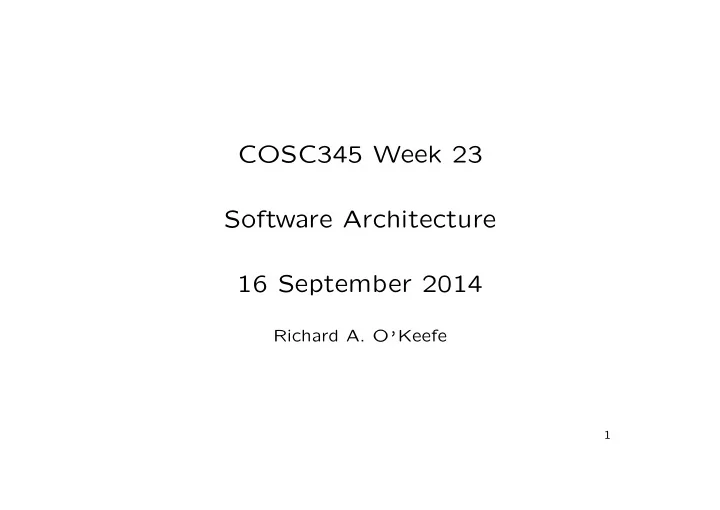

COSC345 Week 23 Software Architecture 16 September 2014 Richard A. O ’ Keefe 1
About Real Architecture The disappointment of Bath: architect-designed fa¸ cades, builder- hacked interiors and backs. The importance of Alexander: “pattern language” idea borrowed for coding. Major idea: rooms, buildings, streets, towns should suit the people who live and work there and should be adaptable by them. Modern architects consider what people do in a house. 2
What is software architecture? HIGH LEVEL design of software system. Says HOW it all works. Uses METAPHOR to help us understand and tell each other about the program we are working on. Is expressed in a range of NOTATIONS. Typically uses HIERARCHICAL decomposition. Boxes (systems and subsystems) and arrows (control/data flow). 3
What do we want from an architecture? → Relatively simple → Makes change easy → Not tied to single platform/vendor → Reusable/reused 4
What are architectures made from? Perry and Wolf (SIGSOFT Software Engineering Notes 17(4):40– 52, 1992) meta-model: Processing elements turn inputs into outputs Data elements are/hold information Connecting elements tie things together (names, paths, flows, rules) Add: refinement relates models at different levels of detail. 5
Architectural styles Shaw and Garlan Software Architecture: Perspectives on an Emerg- ing Discipline characterise architectural styles: What types of components are there? What types of data/control connectors are there? What constraints are there? Examples: data flow, virtual machine, call-and-return, repository, domain-specific, process control. 6
Call/return architectures I A layered architecture is a hierarchy of abstract machines each using the services of the machines below it. Pure layering: machine N+1 uses only machine N , not machine N-1 Example: hardware, microcode, BIOS, operating system services, programming language runtime support, libwww , libxml , XML ap- plication. Example: operating system, X Window System “wire protocol”, Xlib, Xt, Motif, your application. 7
Layering Layer N can be tested before layer N+1 exists. Layer N+1 might be portable to a different implementation of layer N . (Tcl/Tk code portable to UNIX, Windows, MacOS as long as you don ’ t look at lower layers.) Sometimes modelled as DAG of modules, connections show “who calls whom”. 8
Call/return architectures II Traditional OOP has objects interacting via call/return. Processing elements are methods, data elements are objects, con- necting elements are inheritance, relationships, may-call. Java/UML packages are often layered. 9
Process architectures I Classical data-flow models. UNIX pipes-and-filters models. Systolic architectures (meshes, rings, and so on). Distributed programming (JINI, CORBA, DCOM) 10
Process architectures II Client-server architectures Servers enrol in a registry; they provide services. Clients find servers and send them requests. Examples: Sun ’ s NFS (Network File System), 11
Process Architectures: 3-tier Fat client : server does data management, client does application processing and presentation. Same machine or different machines. Thin client : server does data management and application process- ing, client just does presentation. Three-tier : central database server, thinnish client, in between a middleware layer handles authentication, load balancing etc . 12
Repository model Shared data held in a central database. Subsystems exchange data with the repository, little or none with each other. Processing may be triggered by changes to data. Example: CASE environments. Example: some CAD environments. See Sommerville pp 220–221 for advantages/disadvantages. 13
Traceability Requirements document lists requirements. Each has a name or number. System delegates requirements to various subsystems. Subsystems delegate requirements to sub-subsystems. . . Traceability matrix records which subsystems are responsible for which requirements. Sub(sub)systems with no requirement in common shouldn ’ t need to communicate directly. Never forget the audit/logging requirements. 14
Interfaces! Box-and-line diagrams show system structure and communication patterns. Don ’ t ever forget the interfaces. If subsystem A communicates control and/or data to subsystem B , then B must provide an in- terface and A must use it. Do keep interfaces as small and simple as you can. “You Ain ’ t Gonna Need It” but “You Oughta Think About It”. 15
Some design elements are in many places How you make program data persistent How you access external data stores Security Diagnostics, Configuration, Logging Internationalisation and localisation. 16
Reading (1) Pretty much anything in the QA76.754 area of the library. Sommerville, Software Engineering , 7th edition, chapters 11 (mainly), 12 (for distributed systems), and 13 (application architecture). Sommerville, Software Engineering , 6th edition, chapters 10 and 11. Sommerville, Software Engineering , 5th edition, chapter 13. 17
Reading (2) Pressman, Software Engineering, a Practitioner ’ s Approach , sec- tion 10.6, mostly scattered elsewhere. Hamlet and Maybee, The Engineering of Software , section 11.4. Peters and Pedrycz, Software Engineering, an Engineering Ap- proach , chapter 7. Buschmann, Meunier, Rohnert, Sommerlad, & Stal, Pattern-Oriented Software Architecture: A System of Patterns . 18
Reading (3) ∼ ok/345/Yourdon-DFDs.pdf — 50 pages about Data Flow Dia- grams ∼ ok/345/Yourdon JESA.pdf — the Systems Analysis book it came from. ∼ ok/345/swa-sen.pdf — the Perry and Wolf article ∼ ok/COSC345/garlan-shaw.pdf — the Garlan and Shaw paper The Wikipedia. 19
Recommend
More recommend